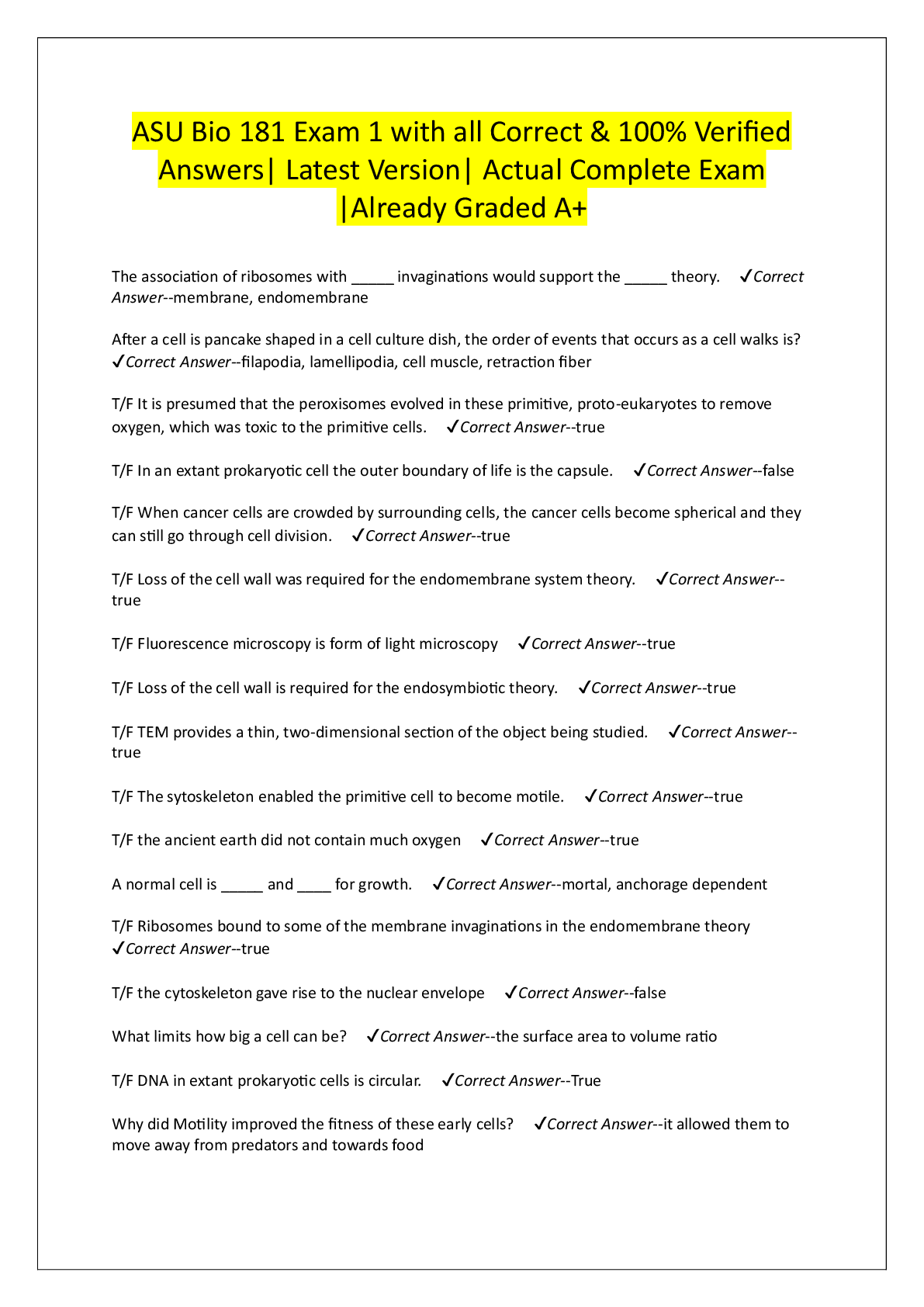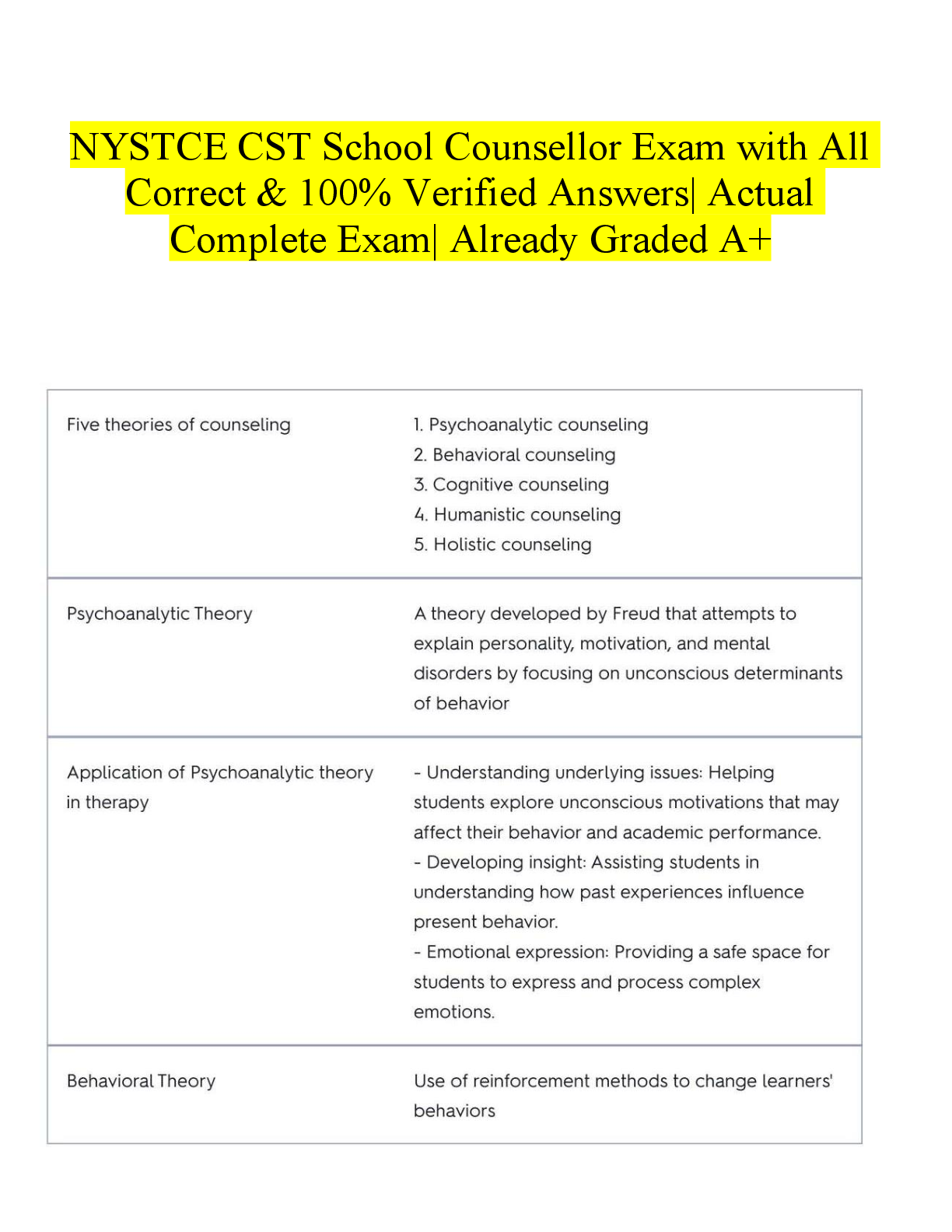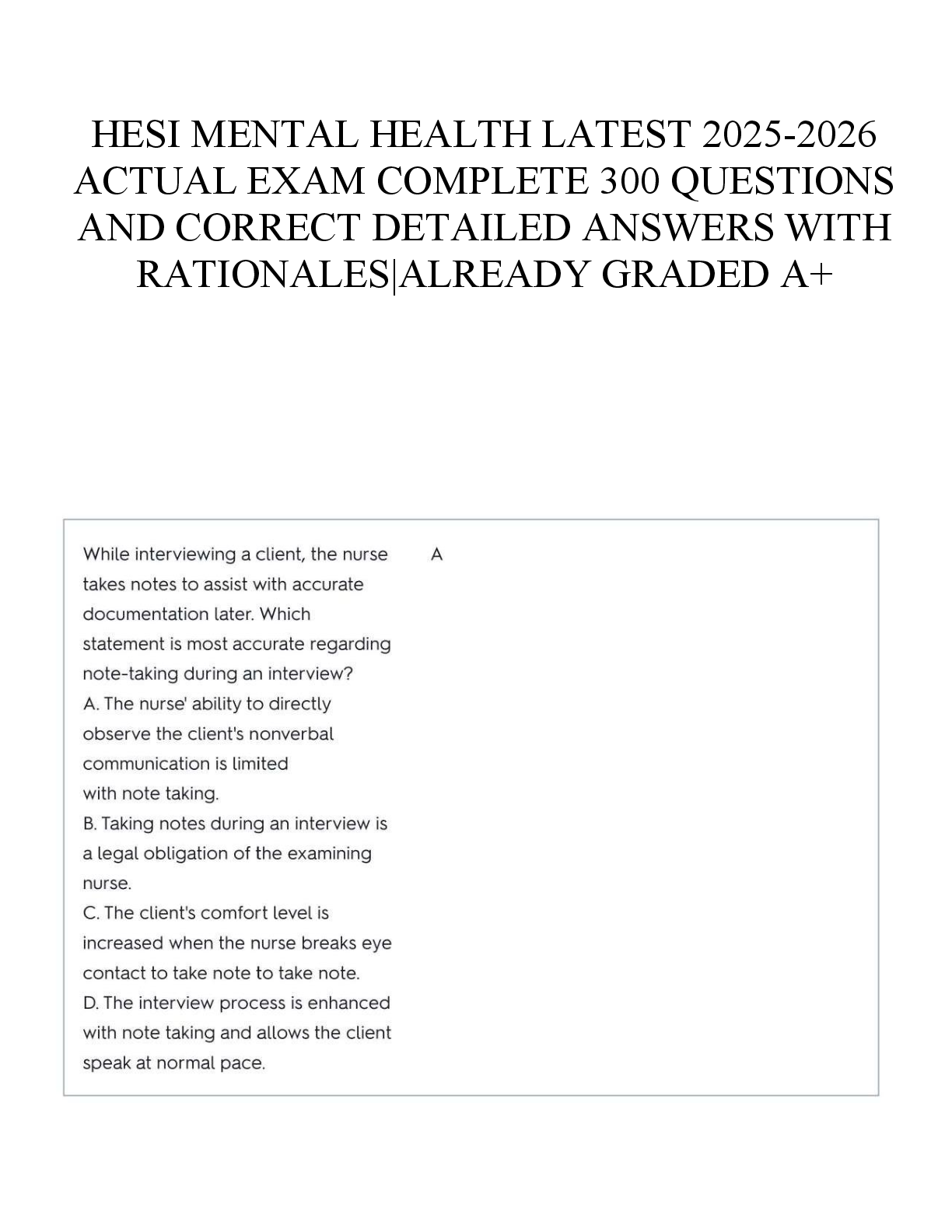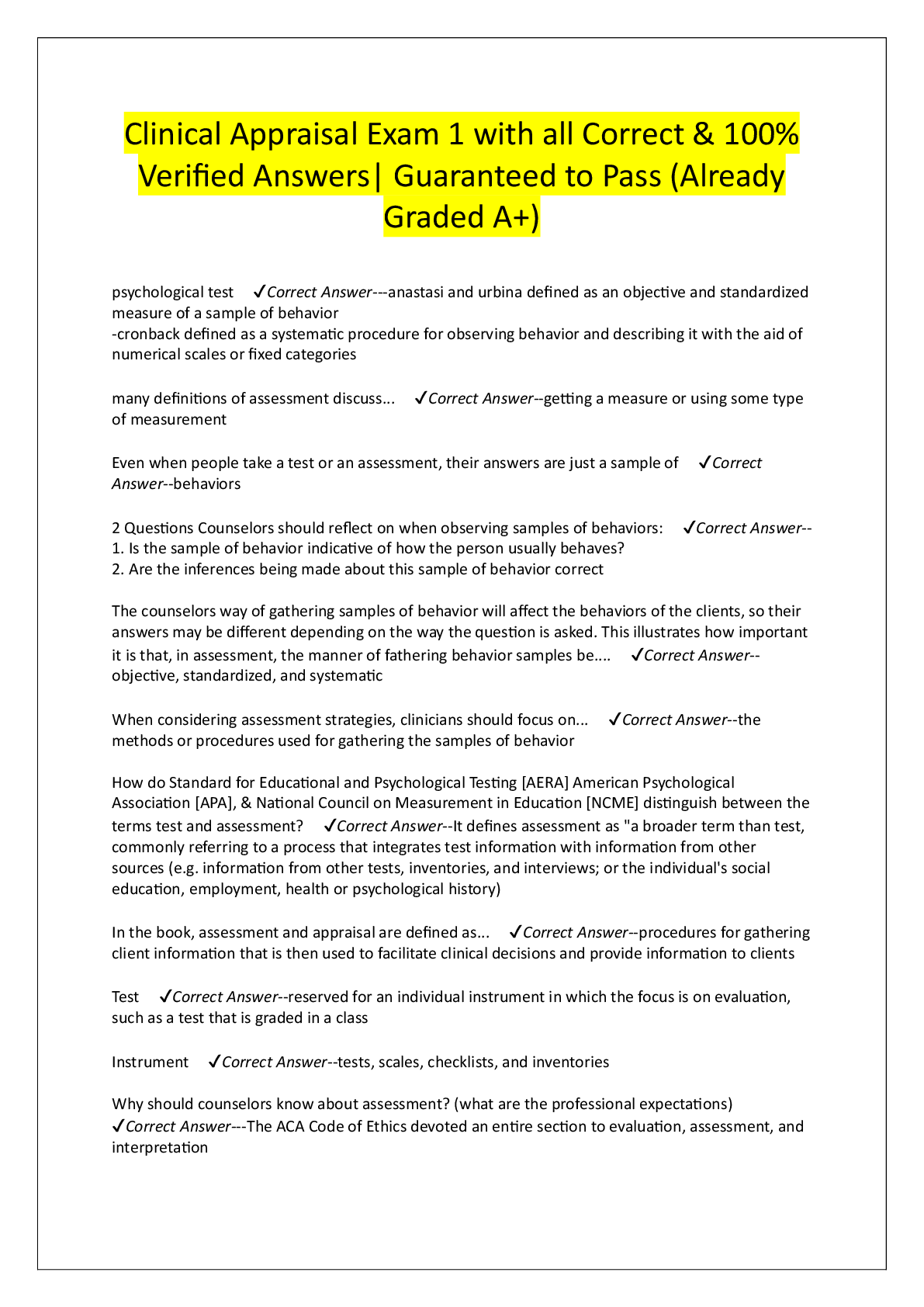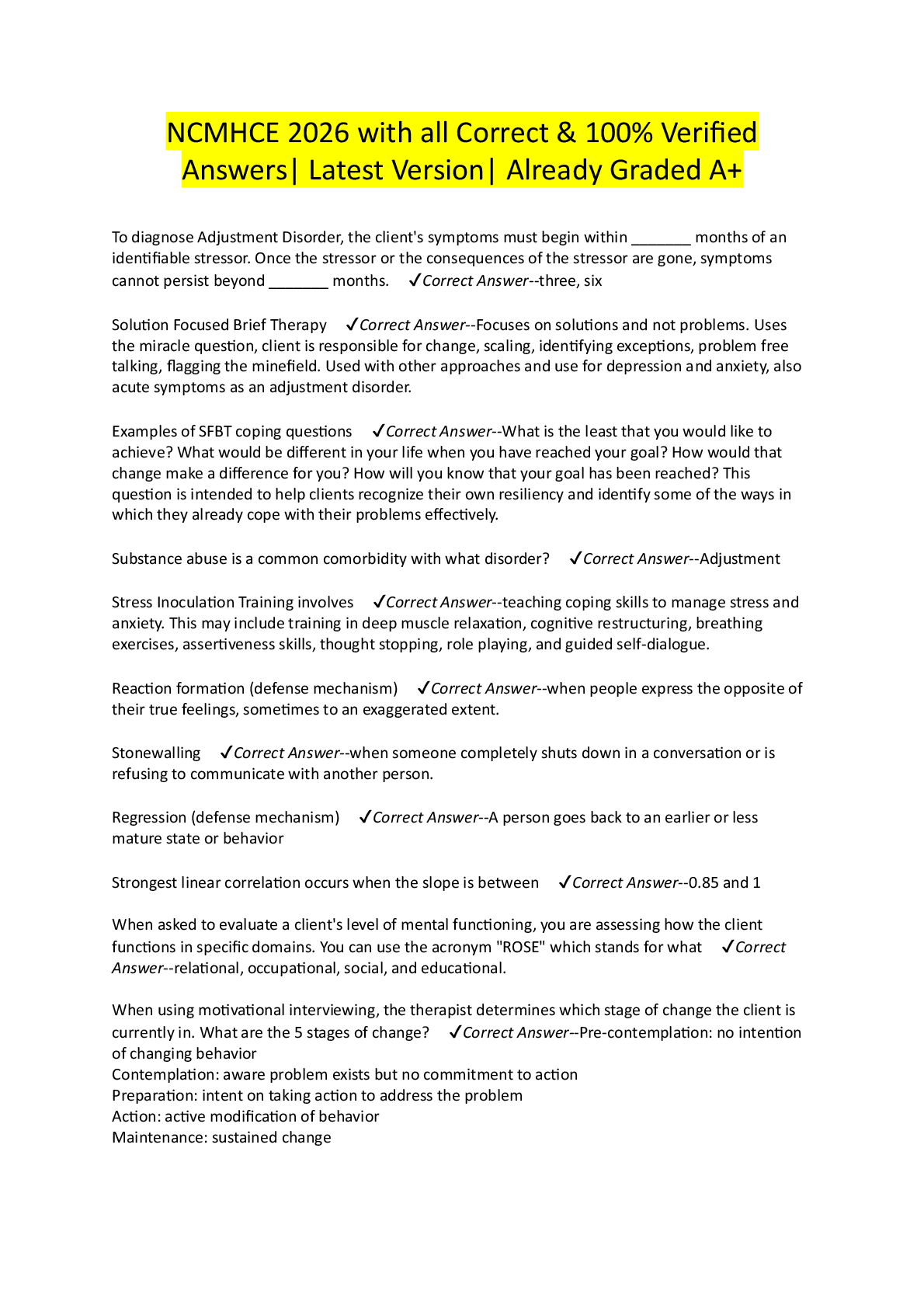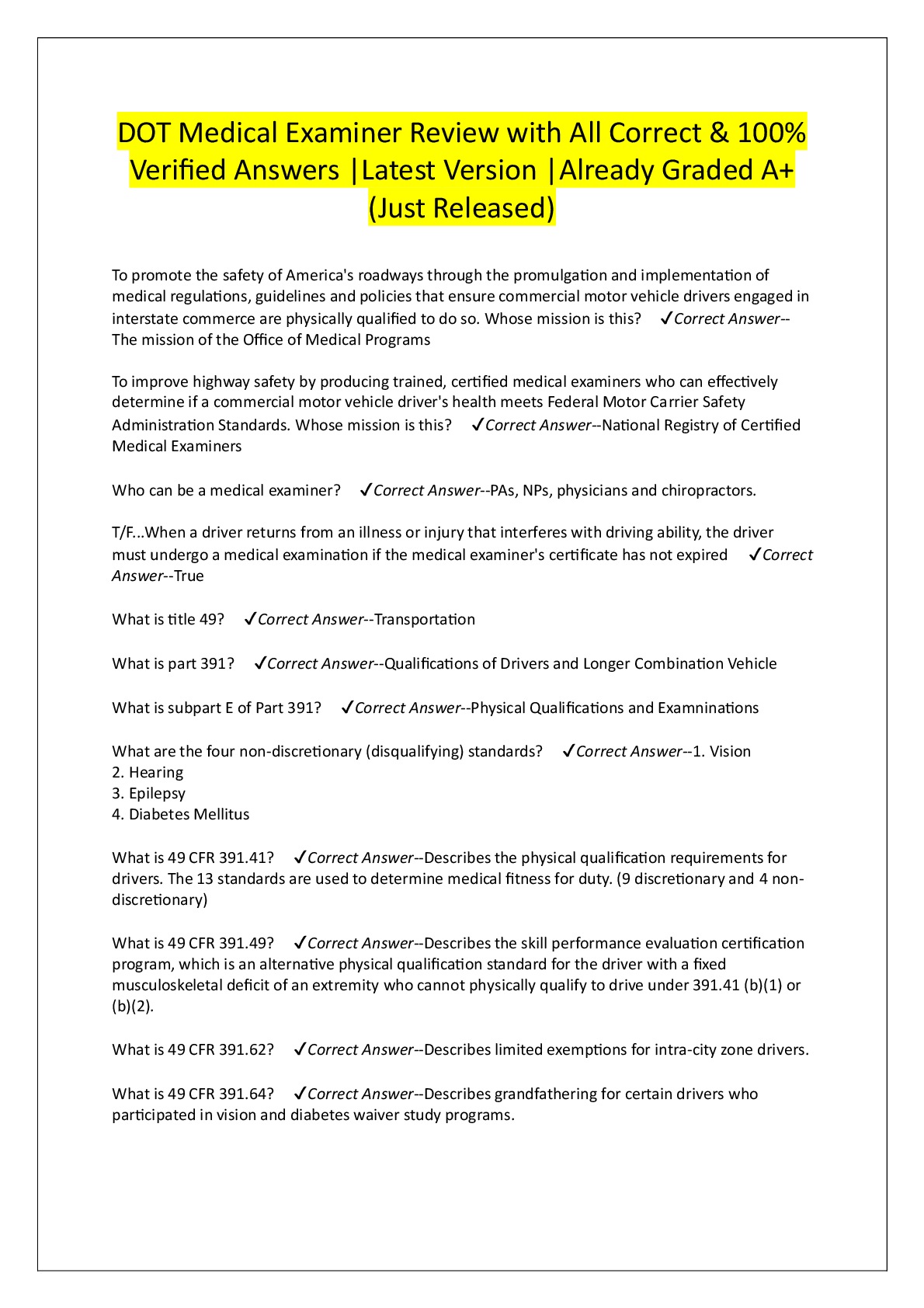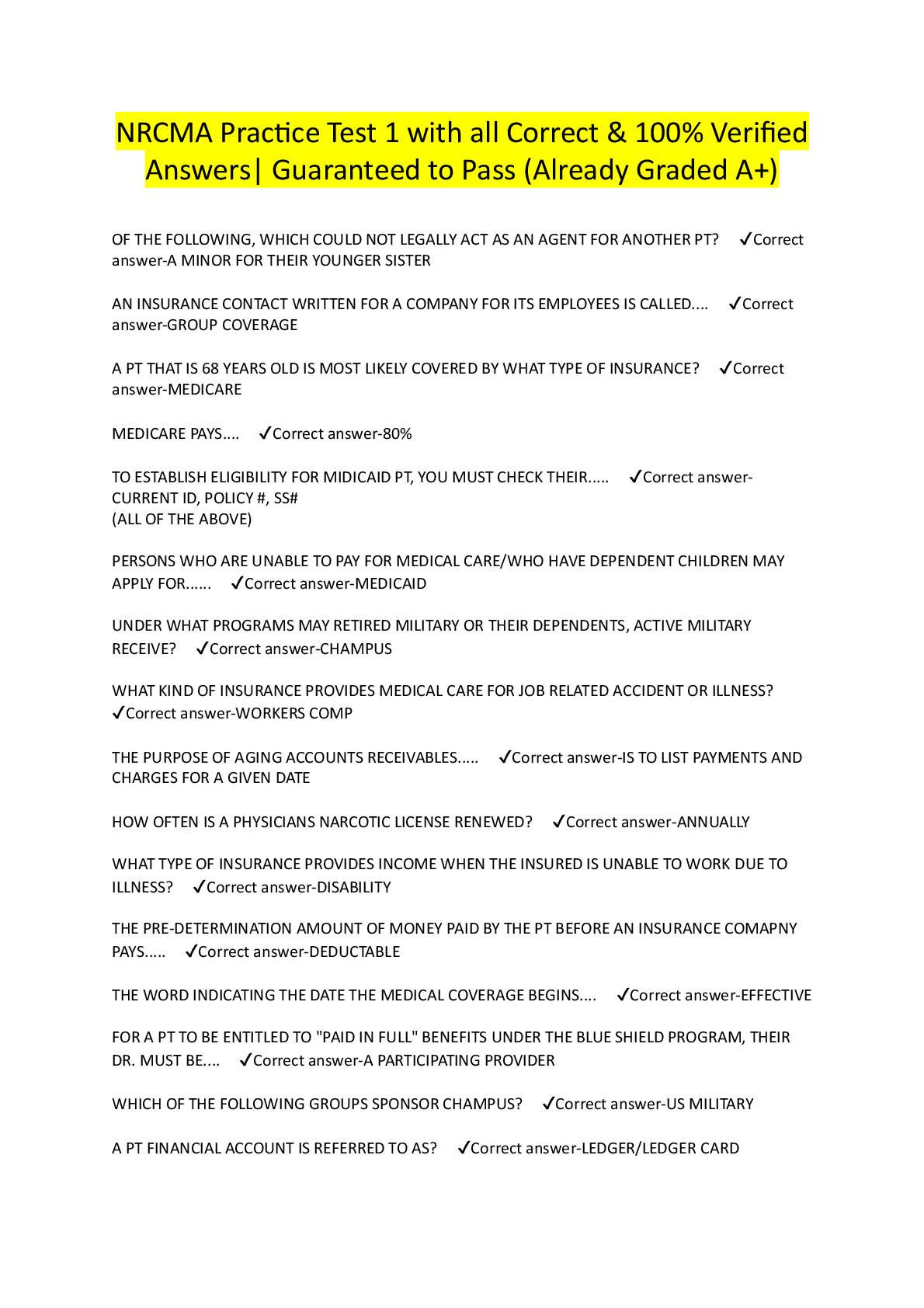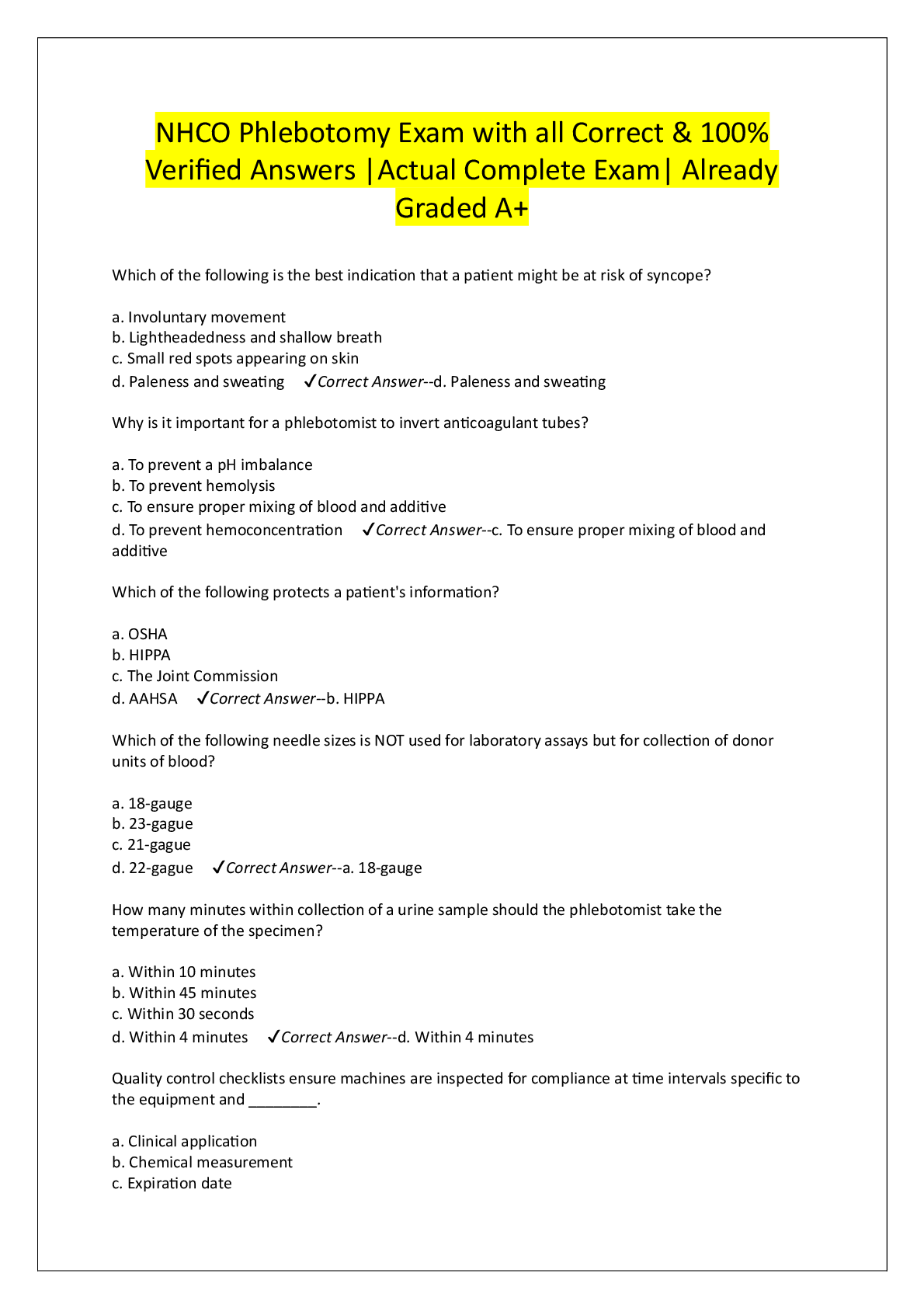*NURSING > EXAM > Study Guide for Final Exam for Advanced Nursing Practice II Question And Answers( Dowlnload To Score (All)
Study Guide for Final Exam for Advanced Nursing Practice II Question And Answers( Dowlnload To Score An A).
Document Content and Description Below
Study Guide for Final Exam 1. Know the causes of an abdominal aortic aneurysm. The proposed causes of AAA include atherosclerosis, inflammation, mycotic infection, inheritable connective tissue diso ... rders (Marfan syndrome, type IV Ehlers-Danlos syndrome), and trauma. Traditionally, atherosclerosis has been considered the most common cause of AAA. However, aneurysm formation is associated with atherosclerosis in only 25% of cases. 2. Why is CT imaging limited in women? Single-photon emission CT imaging is technically limited in women because breast tissue and smaller coronary artery size. 3. What is self-management support? Self-management support is a crucial component of the CCM and effectively implemented by use of a population approach. The goal of self-management support is to engage patients in their own care and to empower them to reach their full potential as self-advocates and partners in care. Before patients can begin self-management, they must have access to information that is appropriate for how they learn and who they are—educationally, cognitively, emotionally, culturally, and experientially. 4. Which Medicare part covers inpatient hospital services? Part A – paid through federal payroll taxes – Covers inpatient hospital services as well as some post-hospital nursing care & home health care 5. Understand risk factors for abdominal aortic aneurysm. Risk factors for AAA include atherosclerotic vascular disease, white race, male gender, advanced age, hypertension, smoking, chronic obstructive pulmonary disease (COPD), history of hernias, family history of AAA, and presence of other aneurysms.4,5 Despite extensive investigation, the link between COPD and AAA remains elusive. Evidence suggests that the high prevalence of AAA in patients with COPD may be related to medications (oral steroids) and coexisting diseases rather than to a common pathway of pathogenesis involving plasma elastase or α1-antitrypsin 6. Study atrial fibrillation and at what age is it more common. Atrial fibrillation is the most common sustained cardiac rhythm disturbance, more common in men and increasing in prevalence with age. It is estimated that 2.3 million Americans have atrial fibrillation, which more commonly occurs after the age of 60years. 7. Where could you find supporting data for guidelines for prevention of future heart disease? The recommendation for asymptomatic women with diabetes, peripheral vascular disease, and possible kidney disease is for secondary prevention strategies to prevent future cardiac events. 8. Can ischemic changes on an ECG during or after an ETT correlate to the effected artery or arteries? It is helpful to correlate the ischemic leads on exercise electrocardiography to the underlying coronary anatomy to roughly identify the culprit artery or arteries. 9. What is the goal of self-management? Self-management support is a crucial component of the CCM and effectively implemented by use of a population approach. The goal of self-management support is to engage patients in their own care and to empower them to reach their full potential as self-advocates and partners in care. For many patients and providers alike, this patient-centered practice is a new method. In the acute care model, clinicians prescribe and patients comply. Self-management support in the CCM requires different assumptions, processes, and skills. 10. Know the symptoms of an abdominal aortic aneurysm. Thromboembolic phenomena may herald the presence of an AAA. Microembolic infarcts in the lower extremity of a patient with easily palpable pedal pulses may suggest either abdominal or popliteal aneurysm. Embolization of mural thrombus from an abdominal aneurysm may be seen with acute limb ischemia caused by femoral or popliteal occlusion. The classic diagnostic triad of ruptured AAA is hypotension (42%), pulsatile abdominal mass (91%), and abdominal pain (58%) or back pain (70%). The triad is encountered in only 50% of patients with a ruptured AAA. Ruptured AAAs should be suspected in any patient who comes in with complaints of hypotension and atypical abdominal or back pain symptoms. In a patient with a history of aneurysm or pulsatile mass, abdominal pain must be considered to represent a rapidly expanding or ruptured aneurysm and must be treated accordingly. In the community setting, the death rate from ruptured AAAs is almost 80%. 11. Know the difference between the principles of fidelity, veracity, self-reflection, and finance. Justice, fidelity, and veracity are ethical principles that health care providers use to guide their professional interactions. When health care providers treat all with respect and address their patient's health care needs, they are following the principle of justice. Adherence to the principle offidelity mandates that health care providers honor their commitments; adherence to veracity compels health care providers to tell the truth and not to be deceptive. When health care providers treat all with respect and address their patient's health care needs, they are following the principle of justice. Whereas we bring considerable thought and reflection to the dilemmas we encounter, the initial reaction of outrage or distress can be quite protective for patients. These emotions highlight the urgency and significance of issues identified in clinical practice and frame approaches to bring best thinking to these dilemmas. Reflective practice is considered to be a means to enhance the identification of clinical concerns and to initiate strategies for assessing and planning care when ethical issues and dilemmas present themselves.8 Reflective opportunities in daily practice allow the practitioner to consider thoughts, feelings, and actions in compelling or difficult cases and then to use team meetings or practice rounds to identify best practice in these cases. 12. Understand the coronary flow related to CAD. CAD exists when coronary arteries are narrowed by atherosclerotic plaque formation, plaque rupture, or spasm. This narrowing impedes coronary blood flow, resulting in hypoperfusion of the myocardium. The hypoperfusion produces first diastolic, and then systolic dysfunction, with characteristic signs and symptoms, including chest pain. Typical ECG changes of ischemia result, although the ST-segment and T-wave changes that are central to demonstration of ischemia occur relatively late in the ischemic cascade. The coronary circulation allows maximum oxygen extraction from the blood when the body is at rest. The healthy coronary circulation can increase flow approximately five times above the baseline level. The fundamental pathophysiologic change in CAD is a limitation of the ability of the coronary arterial circulation to vasodilate appropriately. As a result, the ability to increase coronary blood flow in the face of increased myocardial oxygen demand is limited, leading to an imbalance between oxygen supply and demand and resulting in myocardial ischemia. 13. What pathogen accounts for the majority of cases of pyelonephritis? Pyelonephritis refers to bacterial infection of the upper urinary tract, which includes the kidneys and the ureters, and usually results from ascending infection. A sustained bladder infection and reflux increase the risk for ascending infection. High fever, chills, flank pain, costovertebral angle tenderness, nausea, and vomiting in the presence of urinary symptoms are suggestive ofpyelonephritis. However, kidney infection may also be manifested with only bladder irritation and the absence of any of the classic signs or symptoms. The presence of white blood cell (WBC) casts on microscopy is considered pathognomonic for pyelonephritis. E. coli accounts for more than 80% of acute uncomplicated cases of pyelonephritis.4 Pyelonephritis in male patients suggests an underlying urologic structural abnormality. Renal calculi and embolic infarction can also cause flank pain and hematuria, mimicking pyelonephritis. However, unlike the case with UTIs, urine cultures are sterile and no bacteria are seen on Gram stain.14. 14. What is a Saccular Abdominal Aneurysm? A saccular aneurysm is an asymmetric weakness or bleb on the side of the aorta; these defects result from trauma or an internal wall defect caused by an ulcer. 15. What diagnostic test is used for CAD? The standard first-line approach to initial testing for CAD is the ETT, during which the patient (attached to a 12-lead electrocardiogram) is continuously monitored during graded exercise. Multiple protocols are available for the ETT. 16. How much should the recommended amount of sodium be for a diagnosis of hypertension? The key components of the new guidelines include decreasing daily sodium, cholesterol, alcohol, solid fat, and sugar intake while increasing the intake of vegetables, fruits, low- or fat-free milk products, whole grains, and seafood. Sodium intake should be below 2300mg daily, with hypertensive individuals or those at risk for hypertension maintaining less than 1500mg of sodium intake daily. 17. Which collaboration is the most important when caring for your patients? The patient is the focus and shapes the elements of collaborative practice. The vision of primary care as a collaborative practice is timely and important. Collaborative practice represents the best response that a group of interdisciplinary expert clinicians can offer patients and their families as we move forward to create the new landscape for primary care. Patient concerns determine the discipline that leads the collaborative care effort. Sometimes medicine or nursing directs the health care team; at other times, social services or physical therapy coordinates patient care. The focus of care and attention must be the patient and his or her significant others; therefore, leadership of the health care team varies as the patient's needs change. The most important outcome of collaboration is the enhancement and expansion of efforts and results. Collaborative research is exponentially productive as it combines resources, expertise, and thinking in the creation of knowledge for practice and should include a focus on patient outcomes. Collaborative leadership allows more individuals to participate, and the outcome derives from a collective of minds. Collaboration in clinical practice offers improved quality of care for patients and significant others as professionals share expertise. The vision of primary care as a collaborative practice is timely and important. Collaborative practice models among clinicians have succeeded because they benefit from the synergy between each medical professional's unique skills. Similarly, collaborations between clinicians and academic researchers maximize the expertise of each partner in producing timely and effective clinical research and in translating research into clinical practice. 18. What are the signs of heart failure? Signs and symptoms of heart failure, such as fatigue, dyspnea, and peripheral edema, are often nonspecific; JVD; Crackles, frothy or pink sputum, pleural effusions; 3rd heart sound; 4th Heart sound; aortic stenosis; mitral regurgitation; tricuspid regurgitation; hepatomegaly, right upper quadrant tenderness; ascites, anasarca, or edema; tachycardia; altered hemodynamics; displaced point of maximal impulse; hypotension, cool extremities 19. What phenomenon most often occurs with tachy-arrhythmias? Tachyarrhythmias may be entirely asymptomatic. Symptoms, when they do occur, are in large part related to the ventricular rate, extent of underlying heart disease, ventricular function, and associated precipitating factors. Palpitations are the most common symptom caused by tachyarrhythmias. In patients with paroxysmal attacks, palpitations are usually regular and start and terminate abruptly. Some tachyarrhythmias are well tolerated, but chest discomfort, anxiety, restlessness, shortness of breath, weakness, fatigue, dizziness, and palpitations are common presenting symptoms.3 Any tachycardia associated with chest pressure, acute myocardial infarction or cardiac ischemia, alteration in consciousness, hypotension or shock, shortness of breath, dyspnea on exertion, heart failure, or dizziness requires emergency care and urgent synchronized cadioversion. Because tachycardia can precipitate hemodynamic instability, cardiac monitoring and assessment of vital signs (including temperature, blood pressure, heart rate, respirations, and oxygen saturation) should be continuous. 20. What are strategies in the movement to improve the healthcare system? 21. Where would you measure the J point located on an ECG in relation to the QRS and ST-segment depression after an exercise stress test? A positive test result for CAD is defined by the development of horizontal or down-sloping ST-segment depression of 1 mm measured 80msec after the J point of the QRS complex (the junction between the QRS complex and the ST segment). 22. What is the best reason to add a Doppler flow studies during an echocardiogram study? Transthoracic Doppler echocardiography is rapid and safe and provides information about biventricular systolic performance, wall thickness, and chamber dimensions as well as segmental or regional wall motion abnormalities and valvular function. Evaluation of the mitral, tricuspid, and aortic valves with regurgitation grading is important, as is a determination of estimated pulmonary artery pressures from secondary tricuspid regurgitation. Left ventricular ejection fraction is determined. Diastolic dysfunction can often be detected as well; Doppler echocardiography allows the characterization of abnormal left ventricular filling in diastole. The Advisory Council to Improve Outcomes Nationwide in Heart Failure and the ACC and AHA guidelines both recognize echocardiography as the preferred diagnostic tool for evaluation of the cause of heart failure 23. Who is eligible for Medicare? Medicare is a federal program administered nationally by the CMS and locally by Medicare carrier agencies. Medicare provides health care coverage to (1) persons 65years of age and older who have enrolled in the program and pay premiums and (2) disabled individuals who qualify for Social Security disability payments and benefits. 24. Why would you order an ETT in a symptomatic woman with a normal ECG? For women who are symptomatic but who have a normal resting ECG recording, good exercise tolerance, and no coronary risk factors, an exercise stress test is appropriate; diagnostic imaging is not recommended for low-risk women who are asymptomatic. 25. Know the types of heart failure. Heart failure can be divided into two main types, systolic and diastolic (also called heart failure with preserved systolic function). Systolic heart failure is a reduction in the contractility of the ventricle; diastolic heart failure is impairment of ventricular filling and relaxation. Clinical presentation is wide ranging, from mild, exertionally related dyspnea resulting from fluid retention to cardiogenic shock and lethal arrhythmias. 26. What are the risks for abdominal aortic aneurysm? Risk factors for AAA include atherosclerotic vascular disease, white race, male gender, advanced age, hypertension, smoking, chronic obstructive pulmonary disease (COPD), history of hernias, family history of AAA, and presence of other aneurysms.4,5 Despite extensive investigation, the link between COPD and AAA remains elusive. 27. Does Medicare reimburse nurse practitioners for all services, including those deemed to be exclusive to nursing? NPs cannot bill for their inpatient care under Medicare Part A. Medicare Part B, also known as Supplemental Medical Insurance, covers outpatient services of physicians and other selected providers, home health visits, and rural health clinic services. Part B is paid for from general tax funds and patient premiums. NPs can be reimbursed directly for services provided under Medicare Part B, provided they are “physician services” (i.e., diagnosis, therapy, surgery, consultation, and care plan management). 28. Know the prevalence of sexually transmitted diseases in the USA. Sexual problems are highly prevalent, affecting more than 40% of women in the United States. 29. Understand the different types of stroke and their prevalence. The majority of strokes (87%) are ischemic strokes.3 Approximately 20% of ischemic strokes result from carotid artery disease,6 which is defined as atherosclerotic narrowing of the extracranial arteries, most often at the bifurcation of the carotid artery, with involvement of the proximal internal carotid artery. Carotid stenosis increases from the fifth decade of life onward. In the Framingham Heart Study, the prevalence of moderate carotid stenosis (i.e., >50%) was 7% in women and 9% in men between the ages of 66 and 93years. In the Cardiovascular Health Study of subjects older than 65years, 7% of men and 5% of women had moderate carotid stenosis (50% to 74%); 2.3% of men and 1.1% of women had severe stenosis (75% to 100%).8 Carotid stenosis is more common among persons of European heritage; intracranial arterial stenosis is more common in persons of Asian and other heritage. 30. What is the treatment of choice for uncomplicated community-acquired cystitis? TMP-SMZ is bacteriolytic and relatively inexpensive and therefore considered the drug of choice for the treatment of community-acquired acute uncomplicated cystitis. 31. What physiological changes occur during effort in the routine ETT? In a stress test or ETT, patients are asked to perform incremental exercises that result in positive chronotropic (rate) and inotropic (strength of contraction) stimulation of the cardiovascular system, which in turn increases myocardial oxygen demand. Increases in oxygen demand obligate an increase in myocardial blood flow. The healthy coronary circulation can increase flow approximately five times above the baseline level. The fundamental pathophysiologic change in CAD is a limitation of the ability of the coronary arterial circulation to vasodilate appropriately. The primary goal of the ETT is to increase workload incrementally to induce ischemia or until a predetermined workload is reached. Because the interpretation of the test is based primarily on the development of characteristic ischemic ST-segment and T-wave changes, it is not surprising that resting ECG abnormalities can lead to a reduction in test sensitivity and specificity. The specificity of the routine ETT is reduced if the patient has had a prior myocardial infarction or if the patient has a resting bundle branch block conduction abnormality, paced rhythm, preexcitation syndromes, or inability to exercise because this produces persistent ST-segment and T-wave abnormalities. 32. What predictive value does a significant ST-segment elevation have for CAD? ECG changes such as upsloping ST segment (elevation) or isolated T-wave downsloping (depression) have not demonstrated significant predictive value. Your patient underwent an exercise stress test for CAD. There is significant elevation of the ST-segment. What do you need to know about these changes to manage your patient’s care? 33. How can you determine the cause of a murmur? When a murmur is heard for the first time, it is important to determine whether it is due to a pathologic condition and what type of condition it may represent. The generation of the sounds called murmurs is the same whether the murmur is benign or the result of a severe pathologic condition, and therefore the cause can be difficult to differentiate on the basis of the sound alone. What distinguishes benign from pathologic murmurs is often the characteristics of the murmur, associated physical findings, or symptoms . Murmurs that are due to an increased cardiac output (e.g., as a result of fever, thyrotoxicosis, anemia) may be termed functional because they are caused by excess flow across the outflow tract. Many older adults have decreased mobility of the aortic valves as a result of fibrosis and calcification (aortic sclerosis), which distorts the flow, without producing a significant gradient across the valve. Other older patients may have outflow murmurs that are due to ejection of blood into a kinked, tortuous aorta. A number of adolescents and young adults have ejection murmurs that mimic the flow murmur across the pulmonic valve as a result of an atrial septal defect. This is very common in individuals with pectus excavatum. 34. Understand the different types of stroke and their prevalence. Carotid stenosis may be symptomatic or asymptomatic. Symptomatic carotid stenosis is manifested by its sequelae: transient ischemic attack (TIA), ischemic stroke, and a range of more subtle but enduring neurologic deficits.10 TIA is defined as a syndrome of acute neurologic dysfunction referable to the distribution of a single brain artery and characterized by symptoms that last less than 24 hours without acute infarction.11,12 Ischemic stroke involves a neurologic deficit that persists longer than 24 hours and is associated with permanent infarction.11 Even in the presence of high-grade carotid stenosis, patients may truly be asymptomatic or exhibit nonspecific symptoms that do not qualify as symptomatic ischemic events. The incidence of TIA ranges from 68.2 to 83 per 100,000.13 The prevalence increases with age. A TIA is an important predictor that precedes approximately 15% of strokes. The risk of stroke is highest during the first week after the initial event, 17.3% in the first 30days, as high as 20.1% in the first 90days, and up to 30% within 5years. 35. What is an Isometric ST-segment during exercise caused by? The ECG response of normal hearts is maintenance of an “isoelectric” ST segment during exercise and recovery. 36. Should a patient presenting with symptomatic bradycardia be referred to a cardiologist? Patients with symptomatic bradycardia should be referred to a cardiologist unless a reversible cause can be identified and corrected. Patients with asymptomatic bradycardia may or may not require further intervention; this is determined in large part by the type of block 37. What is the most common cause of systolic heart failure? Coronary artery disease is the most common cause of systolic heart failure. Systolic heart failure is a reduction in the contractility of the ventricle. 38. Understand urinary incontinence and possible causes. Urinary incontinence is the involuntary transient or persistent loss of urine. It is experienced by 30% to 50% of women and 17% of men older than 60years as well as up to 50% of elderly nursing home residents.1 Incontinence is considered to be one of the major causes of institutionalization in the geriatric population, but incontinence is not limited to the elderly. Twenty percent to 30% of young community dwellers are also afflicted by this disorder. Urinary incontinence should not be considered normal at any age and is not an expected outcome of aging. Impaired mobility, pelvic floor weakness, race/ethnicity, weight, other comorbidities (asthma, depression, heart disease), benign prostatic hyperplasia (BPH), medications, and bowel status may all contribute to incontinence. • Stress incontinence: Loss of urine associated with activities that increase intra-abdominal pressure • Urge incontinence: Involuntary loss of urine usually preceded by a strong, unexpected urge to void • Mixed incontinence: Urge and stress incontinence together • Overflow incontinence: An involuntary loss of urine associated with incomplete emptying Urinary incontinence is usually the symptom of an underlying bladder or sphincter condition, but it may also be related to an extrinsic problem that can be easily treated. Stress urinary incontinence (SUI) is leakage of urine with any maneuvers that increase intra-abdominal pressure (coughing, sneezing). The increase in intra-abdominal pressure is transmitted to the bladder, which then overcomes the sphincteric and urethral pressure, resulting in an open urethra and urinary leakage. Stress incontinence is seen in those who have either or both of the following issues. Urge is the most common cause of incontinence in older adults and is manifested as the sudden, often uncontrollable sensation to void. This urge can then lead to urinary urge incontinence (UUI). However, in patients with severe urge, incontinence may not be realized until actual leakage occurs. Overactive bladder is a newer term used to describe the phenomenon of urgency and frequency with or without UUI. Urge and urge incontinence occur because of a rise in detrusor pressure that may be a phasic contraction, detrusor overactivity (DO), or poor bladder compliance. When no defined neurologic contributor can be identified, DO is idiopathic. Prominent theories for DO include increased stimulation of alpha1 receptors in the bladder, disruption of somatic and autonomic nervous systems that help regulate voiding, disruption of afferent and efferent pathways, and increased activation of muscarinic (M2/M3) receptors in the bladder. Patients who have spinal cord injuries below T11-L1,2 or neurologic conditions, such as multiple sclerosis, diabetes mellitus, and spina bifida, can have a disruption in voluntary micturition control. Reflex micturition often results, leading to detrusor hyperactivity and urge incontinence. Incontinence can occur at any age but is more prevalent in the older adult. Changes in the urinary tract that occur with aging can contribute to the development of incontinence. Bladder capacity, contractility, and the ability to postpone voiding are thought to decline with age. Prostate size, urethral obstruction, involuntary bladder contractions, and PVRs, on the other hand, may increase. These changes as well as increased chronic health conditions and medications that affect the urinary tract explain why incontinence is so prevalent in the geriatric population. 39. What defines a positive exercise echocardiogram? A positive exercise echocardiogram is defined by stress- induced decrease in regional wall motion, decreased wall thickening, or regional compensatory hyperkinesis. 40. What condition does narrowed coronary arteries or plague rupture cause? CAD exists when coronary arteries are narrowed by atherosclerotic plaque formation, plaque rupture, or spasm. This narrowing impedes coronary blood flow, resulting in hypoperfusion of the myocardium. 41. What changes would you see during an ETT that are highly predictive of CAD? The standard is the peak heart rate achieved during exercise. Specifically, a test result is considered negative for CAD only if the patient exercises to at least 85% of the age-predicted maximum heart rate without evidence of inducible ischemia (maximum heart rate = [220 − age]). If the patient fails to achieve this “target” heart rate, the test should be considered nondiagnostic or insufficient to exclude ischemia. On the other hand, if there is evidence of ischemia (typical angina, ischemic ST changes) before the patient's target heart rate is reached, the test is considered strongly predictive of significant CAD. A second important predictor of more advanced CAD is exercise-induced hypotension (i.e., a fall in systolic blood pressure of at least 20mm Hg at any point during exercise). 42. What property is common to all cardiac cells? Automaticity, or the ability to depolarize spontaneously, is a property common to all cardiac cells. 43. What does an abnormal left ventricular ejection fraction on an echocardiogram mean for a patient during an ETT? The 2DE evidence for ischemia includes an abnormal left ventricular ejection fraction (LVEF) response to exercise or the development of regional wall motion abnormalities. The sensitivity of the 2DE technique for CAD detection is enhanced in patient subsets with multivessel CAD or prior myocardial infarction. In addition, the sensitivity of exercise echocardiography is decreased in patients with resting wall motion abnormalities. 44. Where do most arrhythmias occur in the heart? More than half of all cardiac arrhythmias arise from or involve the atria. 45. Know the reasons for using the risk stratification according to the Farmingham risk score to justify a ETT in an asymptomatic patient. All patients, even if asymptomatic, require risk stratification according to the Framingham risk score (low, intermediate, or high) to identify CAD risk equivalents. ACC guidelines have as a class I recommendation (suggested) based on class B evidence (limited populations studied) that health care providers ascertain risk for cardiovascular disease in asymptomatic individuals by use of a global assessment such as the Framingham score.4 The ACC guidelines use the level of risk determined by these scores to evaluate the evidence and to classify recommendations for the use of various testing modalities in the investigation and determination of subclinical cardiovascular disease. Your patient has a maximum age-predicted heart rate of 180. During the exercise, he reaches a heart rate of 140 and then states he can no longer exercise. You see no evidence of ischemia on the ECG. This would be diagnostic for what condition? Student Answer: Diagnostic for impending Myocardial Infarction Predictive of no CAD Diagnostic of laziness Has no diagnostic value to rule out CAD (This scenario has no diagnostic value to rule out CAD.) Student Answer: These changes have minimal predictive value for CAD (Significant elevation of the ST-segment has minimal predictive value for CAD. ) These changes predict dire outcomes This patient needs to see someone more experienced in treatment of CAD These changes are predictive of myocardial infarction Ischemic changes on ECG during ETT is highly predictive of CAD. What is another important strong predictor of CAD that you might see during an ETT? Student Answer: Exercise-induced hypertension Exercise-induced hypotension (Another important strong predictor of CAD that you might see during an ETT is exercise-induced hypotension. ) Slow heart rate Rapid heart rate You are counseling a patient diagnosed with stress-induced ischemia. You base your discussion on your knowledge that stress-induced ischemia is thought to be caused by what phenomena? Student Answer: Heart muscle dysfunction Too many carbonated drinks Diet and exercise Endothelial dysfunction of the microvascular (You base your discussion on your knowledge that stress-induced ischemia is thought to be caused by endothelial dysfunction of the microvascular.) [Show More]
Last updated: 3 years ago
Preview 1 out of 13 pages
.png)
Buy this document to get the full access instantly
Instant Download Access after purchase
Buy NowInstant download
We Accept:

Reviews( 0 )
$15.00
Can't find what you want? Try our AI powered Search
Document information
Connected school, study & course
About the document
Uploaded On
Dec 21, 2020
Number of pages
13
Written in
All
Additional information
This document has been written for:
Uploaded
Dec 21, 2020
Downloads
0
Views
141

.png)











